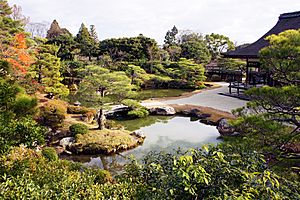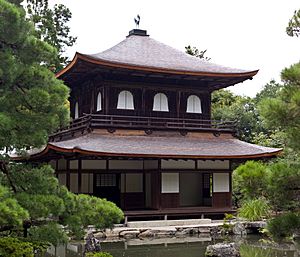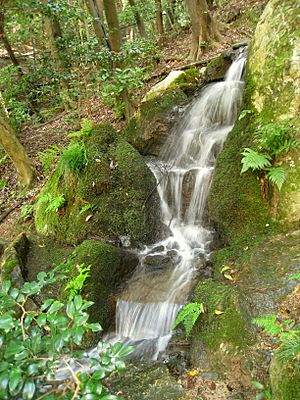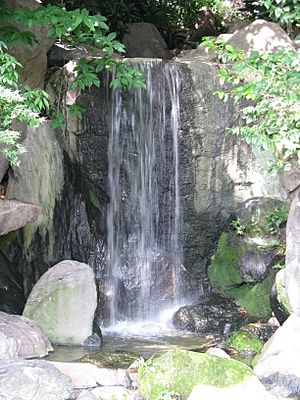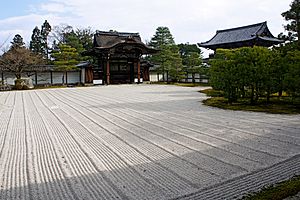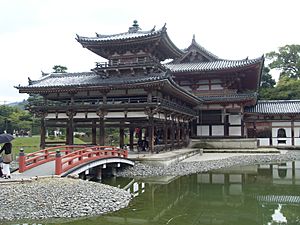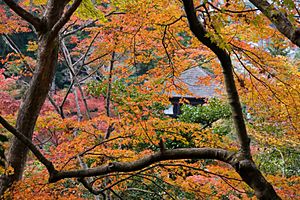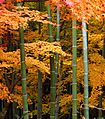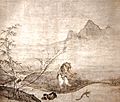Japanese garden facts for kids
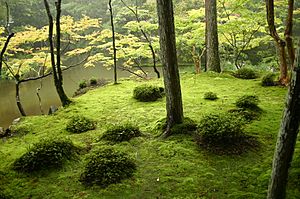
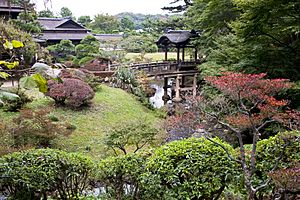
Japanese garden is a traditional kind of garden in Japan. The garden is made to be like a small landscape. The basic principle of a Japanese garden is to create harmony and balance.
Contents
History
The oldest Japanese text on garden-making is Sakuteiki (Records of Garden Making). The work was based on oral traditions which were published for the first time in the 11th century.
Types
There are many types of Japanese gardens, for example,
- The contemplation or thinking style of garden (kanshō) is designed to be studied and enjoyed from one specific place. An example of a kanshō garden is the rock and raked gravel garden at Ryōan-ji in Kyoto.
- The stroll or walking style of garden (shūyū) is intended to be looked at from a path. The garden is discovered as the viewer walks along the path. An example of a shūyū garden is at Ginkaku-ji in Kyoto.
- The boating or pleasure-boat style of garden (funasobi) is centered on a large pond. The best views are seen from a boat in the pond. An example of a funasobi gardem is at Byōdō-in at Uji, which is near Kyoto.
- Many-pleasure style of garden (kaiyū) has a central pond and many paths. It combines aspects of kanshō, shūyū and funasobi gardens. An example of a kaiyū garden is at Katsura Imperial Villa.
Garden elements
Water
The ability to capture the essence of nature makes the Japanese gardens distinctive and appealing to observers. The contrast between western flower gardens and Japanese gardens is profound. "Western gardens are typically optimised for visual appeal while Japanese gardens are modelled with spiritual ideas in mind." Japanese gardens have always been conceived as a representation of a natural setting. The Japanese have always had a spiritual connection with their land and the spirits that are one with nature, which explains why they prefer to incorporate natural materials in their gardens. The main purpose of a Japanese garden is to attempt to be a space that captures the natural beauties of nature.
Japanese gardens always have water, either a pond or stream, or, in the dry rock garden, represented by white sand. In Buddhist symbolism, water and stone are the yin and yang, two opposites that complement and complete each other. A traditional garden will usually have an irregular-shaped pond or, in larger gardens, two or more ponds connected by a channel or stream, and a cascade, a miniature version of Japan's famous mountain waterfalls.
In traditional gardens, the ponds and streams are carefully placed according to Buddhist geomancy, the art and science of putting things in the place most likely to attract good fortune. The rules for the placement of water were laid out in the first manual of Japanese gardens. According to the Sakuteiki, the water should enter the garden from the east or southeast and flow toward the west because the east is the home of the Green Dragon (seiryu) an ancient Chinese divinity adapted in Japan, and the west is the home of the White Tiger, the divinity of the east.
Water flowing from east to west will carry away evil, and the owner of the garden will be healthy and have a long life. According to the Sakuteiki, another favorable arrangement is for the water to flow from north, which represents water in Buddhist cosmology, to the south, which represents fire, which are opposites (yin and yang) and therefore will bring good luck.
Traditional Japanese gardens have small islands in the lakes. In sacred temple gardens, there is usually an island which represents Mount Penglai or Mount Hōrai, the traditional home of the Eight Immortals.
A cascade or waterfall is an important element in Japanese gardens, a miniature version of the waterfalls of Japanese mountain streams. The Sakuteiki described seven kinds of cascades. It notes that if possible a cascade should face toward the moon and should be designed to capture the moon's reflection in the water.
-
Youkoukan Garden in Fukui Prefecture recreates a miniature beach and a mountain
Rocks and sand
Rock, sand and gravel are an essential feature of the Japanese garden. A vertical rock may represent Mount Horai, the legendary home of the Eight Immortals, or Mount Sumeru of Buddhist teaching, or a carp jumping from the water. A flat rock might represent the earth. Sand or gravel can represent a beach, or a flowing river. Rocks and water also symbolize yin and yang, (in and yō in Japanese) in Buddhist philosophy; the hard rock and soft water complement each other, and water, though soft, can wear away rock.
Rocks are arranged in careful compositions of two, three, five or seven rocks, with three being the most common. In a three-arrangement, a tallest rock usually represents heaven, the shortest rock is the earth, and the medium-sized rock is humanity, the bridge between heaven and earth.
In ancient Japan, sand (suna) and gravel (jari) were used around Shinto shrines and Buddhist temples. Later it was used in the Japanese rock garden or Zen Buddhist gardens to represent water or clouds. White sand represented purity, but sand could also be gray, brown or bluish-black.
The specific placement of stones in Japanese gardens to symbolically represent islands (and later to include mountains), is found to be an aesthetically pleasing property of traditional Japanese gardens. Rock placement is a general "aim to portray nature in its essential characteristics" – the essential goal of all Japanese gardens.
-
Ankokuji garden in Hiroshima features rocks of different but harmonious sizes and colors
Garden bridges
Bridges first appeared in the Japanese garden during the Heian period. At Byōdō-in garden in Kyoto, a wooden bridge connects the Phoenix pavilion with a small island of stones, representing the Mount Penglai or Mount Horai, the island home of the Eight Immortals of Daoist teaching, The bridge symbolized the path to paradise and immortality.
Bridges could be made of stone (ishibashi), or of wood, or made of logs with earth on top, covered with moss (dobashi); they could be either arched (soribashi) or flat (hirabashi). Sometimes if they were part of a temple garden, they were painted red, following the Chinese tradition, but for the most part they were unpainted.
During the Edo period, when large promenade gardens became popular, streams and winding paths were constructed, with a series of bridges, usually in a rustic stone or wood style, to take visitors on a tour of the scenic views of the garden.
-
A bridge at Tokushima castle made of two stones resting on a third stone (1592)
Stone lanterns and water basins
Japanese stone lanterns date back to the Nara period and the Heian period. Originally they were located only at Buddhist temples, where they lined the paths and approaches to the temple, but in the Heian period they began to be used at Shinto shrines as well. According to tradition they were introduced to the tea garden by the first great tea masters, and in later gardens they were used purely for decoration. In its complete and original form, a dai-doro, like the pagoda, represents the five elements of Buddhist cosmology.
Stone water basins, (tsukubai) were originally placed in gardens for visitors to wash their hands and mouth before the tea ceremony. The water is provided to the basin by a bamboo pipe, or kakei, and they usually have a wooden ladle for drinking the water. In tea gardens, the basin was placed low to the ground, so the drinker had to bend over to get his water.
Trees and flowers
Nothing in a Japanese garden is natural or left to chance; each plant is chosen according to aesthetic principles, either to hide undesirable sights, to serve as a backdrop to certain garden features, or to create a picturesque scene, like a landscape painting or postcard. Trees are carefully chosen and arranged for their autumn colors. Moss is often used to suggest that the garden is ancient. Flowers are also carefully chosen by their season of flowering. Formal flowerbeds are rare in older gardens, but more common in modern gardens. Some plants are chosen for their religious symbolism, such as the lotus, sacred in Buddhist teachings, or the pine, which represents longevity.
The trees are carefully trimmed to provide attractive scenes, and to prevent them from blocking other views of the garden. Their growth is also controlled, in a technique called Niwaki, to give them more picturesque shapes, and to make them look more ancient. They are sometimes constrained to bend, in order to provide shadows or better reflections in the water. Very old pine trees are often supported by wooden crutches, or their branches are held by cords, to keep them from breaking under the weight of snow.
The most common trees and plants found in Japanese gardens are the azalea (tsutsuji), the camellia (tsubaki), the oak (kashiwa), the Japanese apricot (ume), cherry (sakura), maple (momiji), the willow (yanagi), the ginkgo (ichō), the Japanese cypress (hinoki), the Japanese cedar (sugi), pine (matsu), and bamboo (take).
-
The style of topiary plant sculpture known as o-karikomi in Chionin Garden.
-
Azaleas at Soraku-en Garden
-
Bamboo and Japanese maple combined at Tenryū-ji Garden in Kyoto.
Fish
The use of fish, particularly nishiki-goi (colored carp), or goldfish as a decorative element in gardens was borrowed from the Chinese garden. Goldfish were developed in China more than a thousand years ago by selectively breeding Prussian carp for color mutations. By the Song dynasty (960–1279), yellow, orange, white and red-and-white colorations had been developed. Goldfish were introduced to Japan in the 16th century. Koi were developed from common carp in Japan in the 1820s. Koi are domesticated common carp (Cyprinus carpio) that are selected or culled for color; they are not a different species, and will revert to the original coloration within a few generations if allowed to breed freely.
Images for kids
-
Japanese Garden in the Tatton Park Gardens, England.
-
Ise Jingu, a Shinto shrine begun in the 7th century, surrounded by white gravel
-
The naka-niwa or courtyard garden of a former geisha house in Kanazawa, Ishikawa. The trees are covered with straw to protect them from the snow.
-
Claude Monet, Bridge over a Pond of Water Lilies, 1899, Metropolitan Museum of Art
-
Painting of part of Landscape of the Four Seasons by the monk Tenshō Shūbun from the Muromachi period, showing an idealized Japanese landscape, where man was humble and lived in harmony with nature. This ideal landscape was also depicted in Japanese gardens.
-
Tenryū-ji Garden in Kyoto. (Kaiyū-shiki Garden, completed in the 14th century)
-
Kōraku-en in Okayama. (Kaiyū-shiki Garden, completed in the 17th century)
-
Drop of Water Memorial Hall in New Taipei City, Taiwan.
-
This view from the Symbolic Mountain in the gardens in Cowra, Australia shows many of the typical elements of a Japanese garden.
-
A Japanese zen garden at the Auburn Botanical Gardens, in Auburn, Sydney.
-
Japanese Garden, Tatton Park Gardens
-
Japanese Garden, Tully, County Kildare. Red lacquered arched bridges are Chinese in origin and seldom seen in Japan, but are often placed in Japanese-style gardens in other countries.
-
Brooklyn Botanic Garden's Japanese Hill-and-Pond Garden (Brooklyn, New York); designed by Takeo Shiota, was one of the first gardens to be created in an American botanical garden and reportedly the first one to be accessible free of charge.
-
The Japanese Garden in Przelewice, Poland
-
The Japanese Garden in Lankester Botanical Gardens, Costa Rica
-
Osawa lake in Kyoto was part of the old imperial gardens of the Emperor Saga (809–823).
-
A contemporary Japanese garden at the Kochi Museum of Art
-
The symmetrical and highly ornamental architecture of the Phoenix Hall in Byōdō-in Garden, Kyoto (1052) was inspired by Chinese Song dynasty architecture.
-
Koi in Himeji Koko-en Garden
-
Enjō-ji Temple in Nara Prefecture is a good example of a paradise garden of the late Heian Period.
-
Suizen-ji Jōju-en Garden, begun in 1636, has a miniature replica of Mount Fuji. The trees on the upper part of the hill are trimmed to be smaller, to make the mountain look taller.
See also
 In Spanish: Jardín japonés para niños
In Spanish: Jardín japonés para niños


